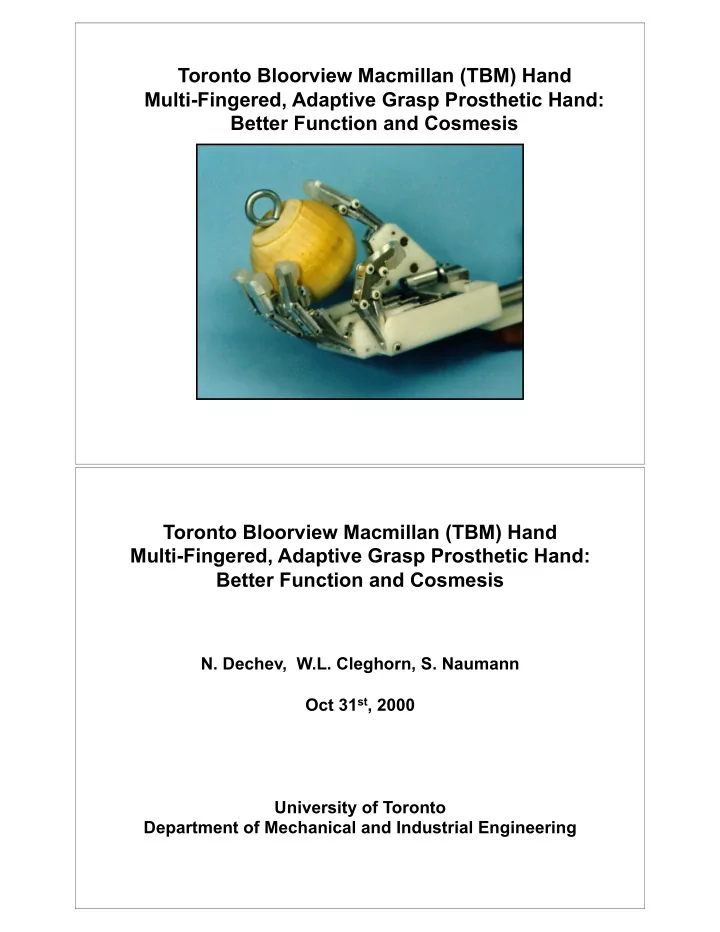

Toronto Bloorview Macmillan (TBM) Hand Multi-Fingered, Adaptive Grasp Prosthetic Hand: Better Function and Cosmesis Toronto Bloorview Macmillan (TBM) Hand Multi-Fingered, Adaptive Grasp Prosthetic Hand: Better Function and Cosmesis N. Dechev, W.L. Cleghorn, S. Naumann Oct 31 st , 2000 University of Toronto Department of Mechanical and Industrial Engineering
Needs and Goals: Need: Current prosthesis have limited finger/thumb motion, limited grasp capability, and are unattractive. Many children reject the use of these devices. Goal: Design a multi-fingered, adaptable grasp prosthesis for children in the 7-11 age group. Further, ensure the design looks, moves and weighs, as naturally as possible. Objectives/Constraints (Measurable Values) : 1) � Lightweight (Less or equal to convention prosthesis) 2) � Small size (Sized for children 7-11 years) 3) � Cosmetic appearance (Very important! static or moving) 4) � Single motor ( 1 DOF Actuation) 5) � Four moving fingers, 1 moving thumb. 6) � Fingers and thumb must ‘curl’ around objects. 7) � Each finger must move independently of others (?!?!) 8) � Thumb must be able to rotate. (At least 90 degrees) 9) � High pinch/grasp force . (At least 20 lbf) 10) � Minimum use of battery power (< or = to convention prosthesis)
Similarly Featured Multi-Fingered Experimental Hands: Prosthetic: Montreal hand [1], Southampton hand [2], Robotic: Belgrade/USC hand [3], Utah/MIT Dextrous hand [4]. Montreal Hand Holding an Orange
Southampton Hand Holding a Pen Final Design Description: Mechanical Features of the TBM Hand � � Six links in each finger � � Four links in the thumb � � Combined weight of fingers, thumb & pins: 45 grams � � Compliant material used on inside finger and thumb links
TBM Prototype Hand Diagram of Assembled Finger
Final Design Description: Limitations to Finger Design � � Finger assembly has one degree of freedom. � � Fingers will not wrap around an object during grasp . Trajectory of Single Degree of Freedom Finger
Final Design Description: Adduction/Abduction of Thumb � � Thumb is unlike fingers, in that it is cable driven, and needs a spring to return open. � � Thumb must swivel about cable axis, for design to work. Diagram of Thumb Assembly
Flexion and Extension Range of Motion of the Thumb Adduction and Abduction Range of Motion of the Thumb
Final Design Validation/Calculations: Working Model 2D TM Simulation Final Design Validation/Calculations: IDEAS TM FEA Simulation
� Design Experimental/Test Results: � Pinch Force: � � The maximum tri-digital pinch force obtained: Prototype Hand: Predicted: 8 lbf Actual: 3.2 lbf VASI 7-11 8 lbf Nick Dechev 18 lbf � � The pinch force is lower than desired. It was hoped to be at least as good as a conventional prosthesis. � Design Experimental/Test Results: Electrical Results: � � Prototype hand consumes more energy per cycle: aprox: 3 times more than VASI 7-11 Speed Results: � � Closing or opening time for the hand is very slow: aprox: 4.5 seconds to form a complete pinch Other hands close or open within 1 to 1.5 seconds
Recommendations for Improvement: � � A transmission design is needed for the hand. The hand needs higher close speed, and higher torque when closed. � � A design similar to the two-speed automatic transmission used by Otto Bock could be implemented. � � A customized glove design. A conventional glove limits the cosmesis of this hand, but does not seem to limit the function. Contributions of this Work � � Design of the cylinder spring adaptive grasp mechanism � � Design of the adduction/abduction thumb � � Design of the curling fingers � � Incorporation of adaptive grasp, curling fingers, and an adduction/abduction thumb into a child sized prosthesis.
Conclusion � � The Design, Construction and Testing of an experimental multi- fingered, adaptable grasp prosthesis for children in the 7-11 age group has been done. � � The design was able to meet most of the objectives of this work, in particular: cosmetics, natural motion, adaptive grasp, curling fingers, light weight, all while using only 1-DOF. � � The objectives of pinch force, and speed were not met, and recommendations to improve this in future, have been made. The Prototype Hand
The End
Recommend
More recommend